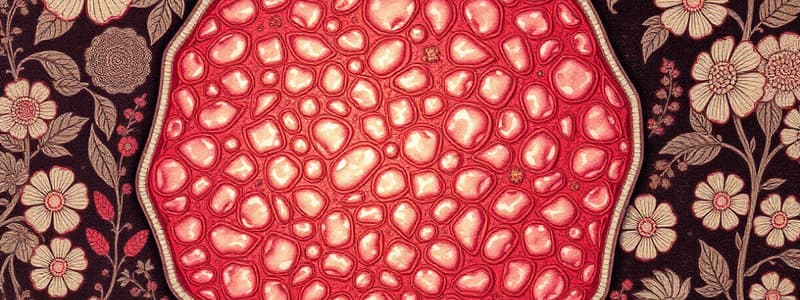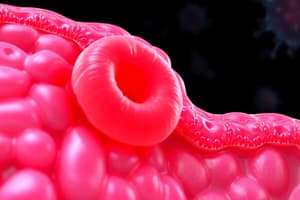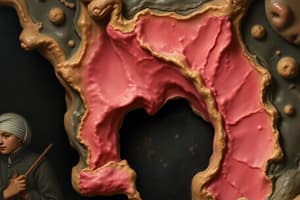Podcast
Questions and Answers
What is the definition of repair?
What is the definition of repair?
- Replacement of damaged cells exclusively with fibrous tissue.
- Healing of tissue with minimal cellular change.
- Replacement of damaged tissue by a new healthy one. (correct)
- Restoration of function to non-dividing cells.
Which type of cells are described as continuously dividing and renewing themselves?
Which type of cells are described as continuously dividing and renewing themselves?
- Labile cells (correct)
- Permanent cells
- Fibroblast cells
- Quiescent cells
In the context of repair, what occurs in fibrosis or gliosis?
In the context of repair, what occurs in fibrosis or gliosis?
- Complete restoration of function in nerve cells.
- Healing by proliferation of adjacent healthy cells.
- Regeneration of labile cells after minor damage.
- Repair by fibrous tissue in permanent cells. (correct)
What phase follows hemostasis in the process of cutaneous wound healing?
What phase follows hemostasis in the process of cutaneous wound healing?
Which type of cells may divide in response to a need, and are classified as stable?
Which type of cells may divide in response to a need, and are classified as stable?
What is the primary purpose of the hemostatic plug formed immediately after injury?
What is the primary purpose of the hemostatic plug formed immediately after injury?
Which of the following is NOT a phase of cutaneous wound healing?
Which of the following is NOT a phase of cutaneous wound healing?
Polymorphs and macrophages play a crucial role in which phase of wound healing?
Polymorphs and macrophages play a crucial role in which phase of wound healing?
What process accompanies the healing of minor damage in labile cells?
What process accompanies the healing of minor damage in labile cells?
Which example is representative of tissue healing by fibrosis?
Which example is representative of tissue healing by fibrosis?
What is the primary role of macrophages in wound healing?
What is the primary role of macrophages in wound healing?
Granulation tissue is mainly composed of which two components?
Granulation tissue is mainly composed of which two components?
Which type of wound healing occurs without significant tissue loss?
Which type of wound healing occurs without significant tissue loss?
What is responsible for the process of wound contraction?
What is responsible for the process of wound contraction?
Which general factor does NOT affect wound repair?
Which general factor does NOT affect wound repair?
Which condition is classified as a complication of wound healing?
Which condition is classified as a complication of wound healing?
What type of scar results from healing by secondary union?
What type of scar results from healing by secondary union?
What process involves the migration of healthy epidermal cells during wound healing?
What process involves the migration of healthy epidermal cells during wound healing?
What enzyme is involved in the degradation of excess collagen during wound remodeling?
What enzyme is involved in the degradation of excess collagen during wound remodeling?
Which of these is NOT categorized as a complication of wound healing?
Which of these is NOT categorized as a complication of wound healing?
Flashcards
Regeneration
Regeneration
Replacing injured tissue with new, healthy tissue of the same type.
Fibrosis or Gliosis
Fibrosis or Gliosis
Replacing damaged tissue with fibrous tissue or glial tissue (in the central nervous system).
Labile Cells
Labile Cells
Cells that continuously divide and renew themselves, like skin epithelium, lining of the digestive system, and blood cells.
Quiescent Cells (Stable)
Quiescent Cells (Stable)
Signup and view all the flashcards
Permanent Cells
Permanent Cells
Signup and view all the flashcards
Hemostasis
Hemostasis
Signup and view all the flashcards
Inflammation
Inflammation
Signup and view all the flashcards
Granulation Tissue Formation
Granulation Tissue Formation
Signup and view all the flashcards
Fibrous Tissue Formation and Remodeling
Fibrous Tissue Formation and Remodeling
Signup and view all the flashcards
Wound Healing
Wound Healing
Signup and view all the flashcards
What are macrophages?
What are macrophages?
Signup and view all the flashcards
What is Angiogenesis?
What is Angiogenesis?
Signup and view all the flashcards
What is Granulation Tissue?
What is Granulation Tissue?
Signup and view all the flashcards
What is Wound Contraction?
What is Wound Contraction?
Signup and view all the flashcards
What is Healing by Primary Union (First Intention)?
What is Healing by Primary Union (First Intention)?
Signup and view all the flashcards
What is Healing by Secondary Union (Second Intention)?
What is Healing by Secondary Union (Second Intention)?
Signup and view all the flashcards
What is an Ulcer?
What is an Ulcer?
Signup and view all the flashcards
What is a Sinus?
What is a Sinus?
Signup and view all the flashcards
What is a Fistula?
What is a Fistula?
Signup and view all the flashcards
What is a Hypertrophied Scar?
What is a Hypertrophied Scar?
Signup and view all the flashcards
Study Notes
Repair Definition
- Repair is the replacement of damaged tissue with a new, healthy one.
Intended Learning Objectives
- Recall the definition of repair.
- List cell types based on their division capabilities.
- Describe different repair types with examples.
- List phases, types, complications, and factors affecting wound healing.
Cell Types Based on Division Power
- Labile cells: Continuously divide and renew themselves. Examples: skin epithelium, mucosal lining of the gastrointestinal tract (GIT), and hematopoietic cells (blood cells).
- Quiescent (Stable) cells: Divide only when needed. Examples: liver, kidney, pancreas, smooth muscle, and fibroblasts.
- Permanent cells: Non-dividing cells. When injured, healing occurs through fibrous or glial tissue (in the central nervous system, or CNS). Examples: nerve cells and skeletal and cardiac muscle cells.
Types of Repair
- Regeneration: Replacement of damaged cells with new, identical cells. This happens through proliferation of adjacent healthy cells. Occurs with minor damage to labile and stable cells. Examples: mild liver injuries and bone fractures.
- Fibrosis or Gliosis: Replacement of damaged tissue with fibrous tissue or glial tissue (in the CNS). This occurs during the healing process of permanent cells or stable cells with significant damage. Examples: myocardial infarction healed by fibrosis; cerebral infarction healed by gliosis.
Wound Healing Phases
- Hemostasis: Immediately after injury, blood vessels bleed into the wound defect, forming a blood clot that temporarily seals the wound. This involves vasoconstriction, platelet aggregation and adherence to damaged endothelium, and stimulation of the coagulation system (forming fibrin). The fibrin network forms a hemostatic plug that stops bleeding.
- Inflammation: Mediated by polymorphs (PMNs) and macrophages. During the first 6-8 hours, PMNs eliminate any pathogens and liquefy necrotic debris. Monocytes (macrophages) also enter the wound to engulf the remaining debris.
- Granulation Tissue Formation and Re-epithelialization: In 5-7 days, fibroblasts migrate into the wound. Angiogenesis (formation of new capillaries) happens from healthy blood vessels at the wound edges. These capillaries fill the wound defect. Newly formed capillaries joined with fibroblasts form granulation tissue. Re-epithelialization is the proliferation and migration of healthy epidermal cells from the wound edges inwards.
- Fibrous Tissue Formation and Remodeling: After 3 weeks, fibroblasts deposit collagen fibers (types I and III). Macrophages secrete collagenase enzymes that degrade excess collagen in a controlled manner (remodeling).
- Wound Contraction: Myofibroblasts (modified fibroblasts, resembling smooth muscle cells) contract to strengthen the healing wound.
Types of Wound Healing
- Primary union (first intention): Healing of clean, non-gaping wounds (e.g., stitched surgical incisions). The resulting scar is small, thin, regular, and flat.
- Secondary union (second intention): Healing of wounds with extensive tissue loss (e.g., large wounds, infected wounds, abscesses, ulcers). The resulting scar is large, thick, irregular, and elevated.
Factors Affecting Repair
- Local factors: Type of damaged cells (labile, stable, or permanent), severity of damage, presence of foreign bodies, necrotic tissue, infection, irradiation, and blood supply.
- General factors: Age of patient, nutritional status, diseases (diabetes, malignancy, anemia), and drugs (corticosteroids, chemotherapy).
Complications of Wound Healing
- Ulcers: Discontinuity of the surface epithelium (skin or mucous membrane).
- Sinus: Blind end track connecting an abscess cavity to the outside. Examples: pilonidal sinus.
- Fistula: Tract connecting two epithelial surfaces. Examples: perianal fistula.
- Weak atrophic scars: Can lead to hernias.
- Hypertrophic scar: Large scar that does not extend beyond the original wound boundaries.
- Keloid formation: Large scar that grows beyond the original wound boundaries and infiltrates surrounding tissue.
- Wound contracture: Exaggerated wound contraction, potentially causing functional disabilities.
Studying That Suits You
Use AI to generate personalized quizzes and flashcards to suit your learning preferences.




